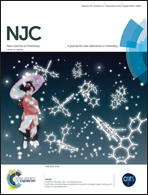A polydiacetylene–nested porphyrin conjugate for dye-sensitized solar cells†
Abstract
A polydiacetylene (PDA)–nested zinc-porphyrin derivative was prepared and investigated for its potential applicability in dye-sensitized solar cells (DSSCs). Absorption enhancement at 525–625 nm was observed as a proof of successful PDA formation. Cyclic voltammetry analysis suggested the appropriate positions of the highest occupied molecular orbital (HOMO) and the lowest unoccupied molecular orbital (LUMO) energy levels of the target material for DSSCs. Optimum DSSCs based on the PDA–nested zinc-porphyrin exhibited a short-circuit photocurrent density (Jsc), an open-circuit voltage (Voc) and a fill factor (FF) of 4.2 mA cm−2, 0.7 V and 0.78, respectively, with an overall power conversion efficiency (PCE) of 2.3%. The photovoltage decay analysis also indicated that the electron recombination lifetime of the cells was prolonged as a result of the presence of the PDA-containing C25 alkyl chains in the porphyrin dye system.


 Please wait while we load your content...
Please wait while we load your content...